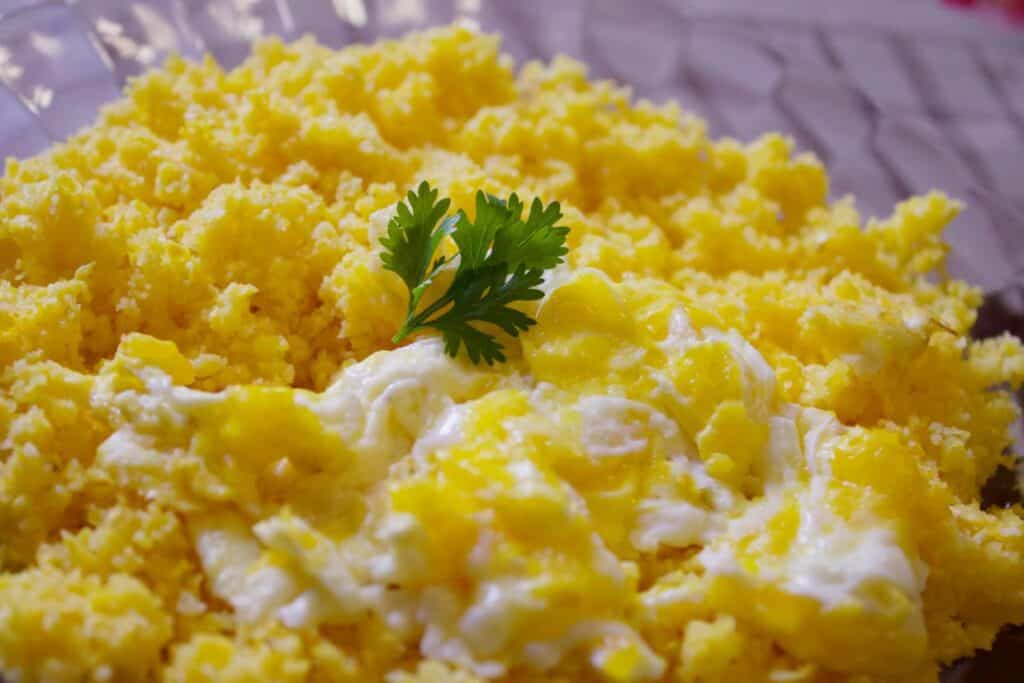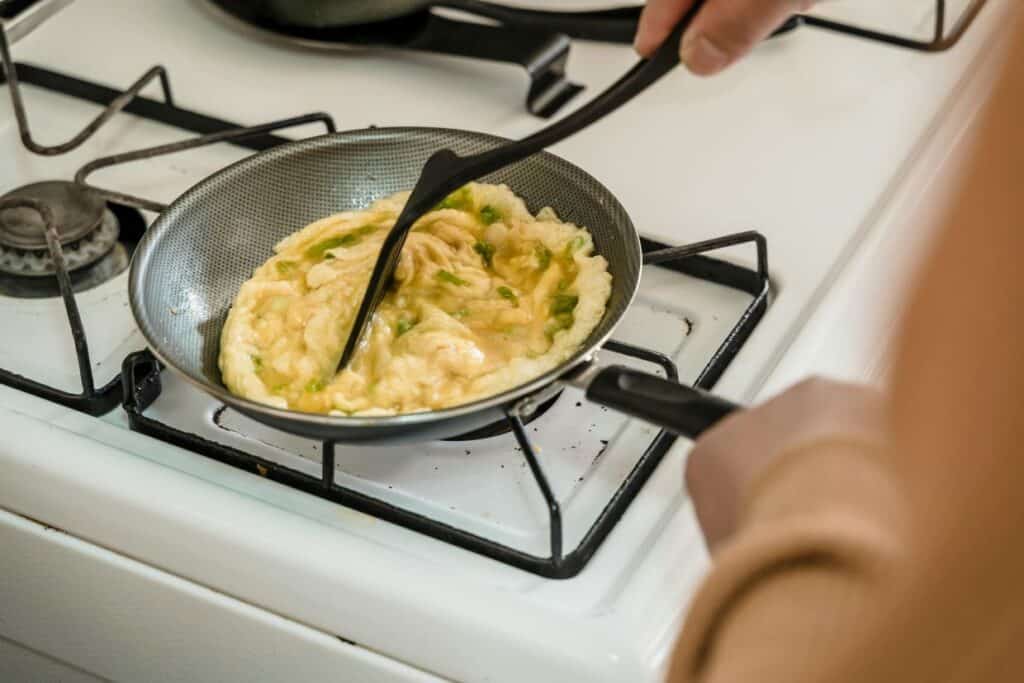Learning to make fluffy scrambled eggs blends art with essential cooking skills. This beloved breakfast favorite is celebrated globally for its simplicity, versatility and the cozy, familiar feel it brings to the table.

The quest for the perfect scrambled egg involves a variety of techniques and ingredient choices, from adding dairy to enrich the flavor to carefully managing the heat level during cooking. Mastering the technique to achieve that sought-after tender and fluffy texture can elevate simple scrambled eggs into a truly exquisite dish.
The key factors in creating fluffy scrambled eggs lie in the details of preparation and cooking methodology. Using fresh eggs, cooking on low heat and employing the correct tools can make a significant difference. Once you’ve mastered how to make fluffy scrambled eggs, you can use those eggs in the beloved breakfast burrito.
Ingredients required
To learn how to make fluffy scrambled eggs, you’ll need a selection of basic ingredients combined with a touch of culinary finesse. The ingredients are simple and often readily available in most kitchens.
- Eggs: This is the main ingredient. Typically, two to three eggs per person will suffice.
- Butter or oil: Using either butter or oil is essential for preventing the eggs from sticking to the pan and for adding richness. A small amount, such as a tablespoon, is often enough. Flavored homemade butter adds a nice touch to the eggs.
- Milk or cream: A splash of milk or cream can be added to the eggs before cooking to enhance their fluffiness and creamy texture; however, it’s not a necessity.
- Salt and pepper: A pinch of each brings out the flavor of the eggs.
- Cheese: Soft cheeses like goat cheese can be crumbled in for an added gourmet touch, though this is entirely optional.

Preparation basics
The initial steps are crucial when making fluffy scrambled eggs. Make sure to gather your ingredients before you begin.
Egg mixture
Begin by cracking the eggs into a bowl. For every two eggs used, add a tablespoon of milk or cream for extra fluffiness. Whisk the eggs vigorously until the mixture is homogeneous and slightly frothy. If desired, add a pinch of salt.
Cooking pan and temperature
Choose a nonstick skillet to prevent the eggs from sticking and tearing. Heat the skillet over a low-temperature setting. Add a generous amount of butter, and let it melt without browning.
Cooking process
Once the butter begins to foam, pour the egg mixture into the pan. Let the eggs sit momentarily to form slight curds at the edges before gently stirring with a spatula. Continuously scrape the eggs from the skillet’s surface while avoiding continuous stirring to maintain a fluffy texture. Practice patience; cook the eggs slowly until they are no longer liquid but still appear moist.
Following these basic steps can lead to fluffy scrambled eggs that are soft and full of volume. Adjustments in cooking time and temperature may be needed based on stove and pan characteristics.
“Scrambled eggs is one of those dishes that is both stupidly simple and really easy to mess up. My number one tip is to whisk the eggs — ideally with a wire whisk, but a fork works in a pinch — until just fully combined. Be careful not to over-whisk them, which can make them rubbery. Keep the heat moderate and move the eggs around gently as they cook. Finally, take the pan off the heat when the eggs are still not completely set on top. The residual heat will finish cooking them without drying them out.”
— Robin Donovan, Eggs All Ways
Whisking technique
The right whisking technique is essential for incorporating air into the eggs, which is the secret to fluffy scrambled eggs. Mastery of egg beating and air incorporation will yield the best results.
Egg beating
To begin, crack the eggs into a bowl and beat them until they are a uniform pale yellow hue. The method of beating is important. It’s recommended to vigorously whisk until you see a significant number of small bubbles. This process evenly distributes the yolk and whites.
Incorporating air
For optimal fluffiness, air must be introduced into the eggs during whisking. The goal is to create a foamy texture on top. Gentle yet swift wrist motion helps achieve this desired effect without overworking the eggs.

Cooking process
Achieving fluffy scrambled eggs relies on precision in the cooking process, from the temperature setting of the pan to the gentleness of stirring. Each step is critical to create the perfect texture.
Pan heating
Begin by setting the pan over low heat; patience here is crucial. Starting with low heat ensures the eggs cook evenly without burning.
Egg pouring
Once the pan reaches the desired temperature, it’s time to pour the vigorously whisked eggs in. The eggs should hit the pan and not sizzle aggressively. If they do, the pan might be too hot.
Stirring method
The eggs need constant attention with deliberate but gentle stirring. Use a rubber spatula to fold the eggs continuously. Movement is key, constantly pushing them from one end of the skillet to the other.
Troubleshooting on how to make fluffy scrambled eggs
When making fluffy scrambled eggs, cooks sometimes encounter issues that can affect the texture and taste. Here are common problems and how to fix them:
- Eggs are not fluffy: This often occurs because the eggs are cooked at too high a temperature. To fix this, keep the heat low and cook the eggs slowly to prevent them from becoming tough and flat.
- Eggs are too runny: If the scrambled eggs are too runny, they may be undercooked or contain too much liquid. Limit fluids like milk and cook the eggs until all the liquid has set.
- Eggs turn rubbery: Overcooking eggs will cause them to release moisture and become rubbery. Once the eggs begin to set, reduce the heat and gently fold them until they’re just cooked through.
- Eggs stick to the pan: This occurs when the pan isn’t adequately non-stick or isn’t properly lubricated. Use a non-stick or ceramic pan with enough butter or oil to create a thin layer on the bottom of the pan.
- Uneven cooking: To avoid this, continuously stir the eggs and don’t allow them to sit untouched for too long. Cooking in a cold pan can also help ensure even heat distribution from the start.
Wrapping up
Mastering fluffy scrambled eggs is all about technique — from how you beat the eggs to how you cook them. By following these detailed steps and tips, you’ll be able to elevate a simple dish into a delightful, gourmet breakfast. Experiment with different flavors and find your perfect combination to start your day deliciously.
Trina Krug, MS, CDSP is a holistic nutritionist, recipe creator and advocate for human health. Her passion for low carb lifestyles, gluten free eating and real nutrition education has led to the creation of Trina Krug. She spends her time creating recipes, hanging out with her family on her farm and actively working on her Doctor of Science in Integrative Health.